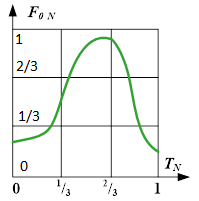How it works
Next Home
 Normalized space for UMP is presented as a rectangle with axes (TN, F0N).
Normalized space for UMP is presented as a rectangle with axes (TN, F0N).
The interval [0 - 1/3] on the abscise TN is a pre-nucleus,
[1/3 - 2/3] is a nucleus, and
[2/3 - 1] is a post-nucleus.
The intervals on the ordinate F0N: [0 ‑1/3] - low level,
[1/3 - 2/3] - mid level,
[2/3 - 1] - high level.
| Type of tone | No | Pitch varieties | Types of utterances. Common usage. | Typical examples |
|---|---|---|---|---|
| Rising | 1 | Mid Wide | General, Elliptical questions, Tags | Is it di+fficult? |
| 2 | Low Wide | General questions, Tags, Non finality | Can I speak to Ma+ry? | |
| 3 | High Narrow | Interrogative repetitions | Na+tive? | |
| 4 | Low Narrow | Statements, Tags | Ye+sterday. | |
| Falling | 5 | High Wide | Statements, Imperatives, Special questions | Li+sten to me, please! |
| 6 | Mid Wide | Statements, Imperatives, Tags, Special questions | Whe+re is she? | |
| 7 | Low Narrow | Statements, Imperatives, Tags | It’s in the So+uth. | |
| Falling-Rising | 8 | Undivided | Imperatives, Questions, Statements, Non-finality, Conversational formulas | They are re+ady. |
| 9 | Divided | No+t no+w. | ||
| Rising-Falling | 10 | Undivided | Statements, Special questions | It’s wo+nderful. |
| * In this table the [+] sign indicates the position of the nuclear vowel of the phrase. | ||||